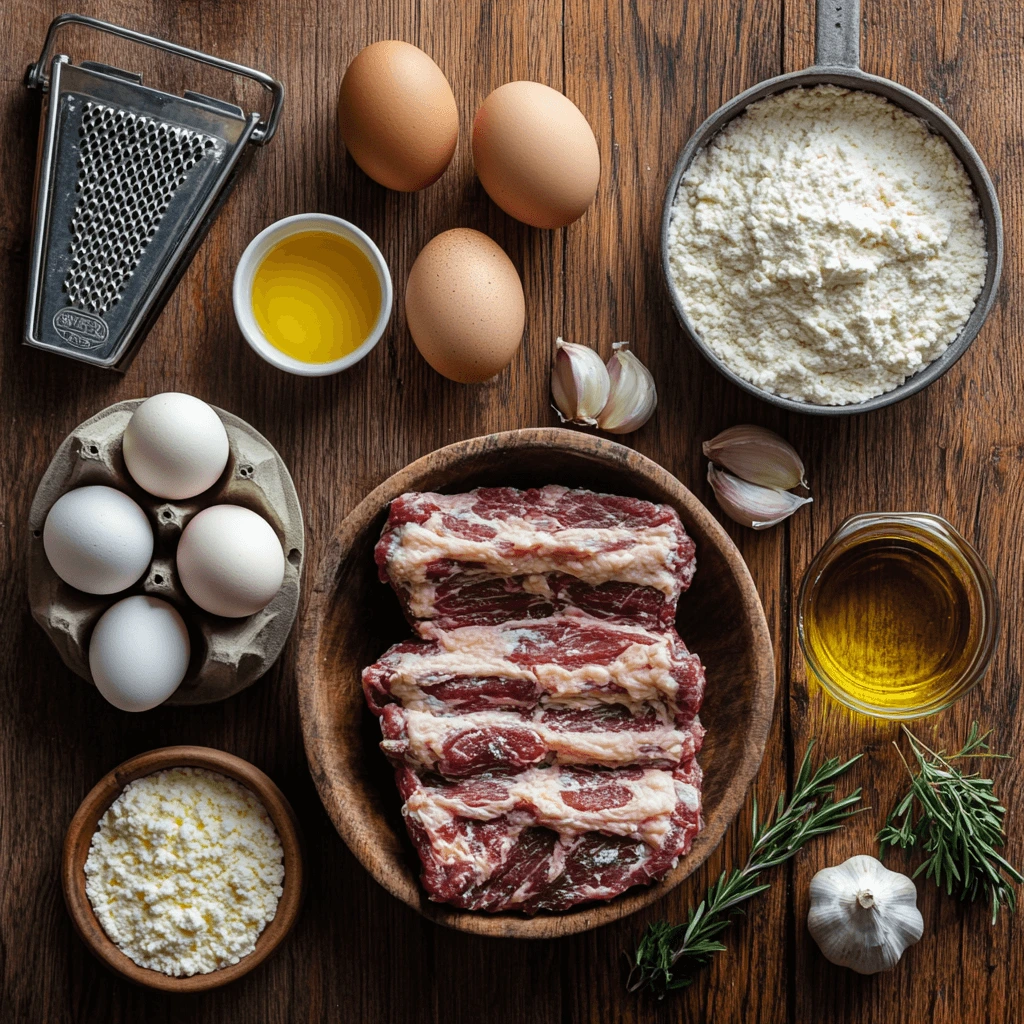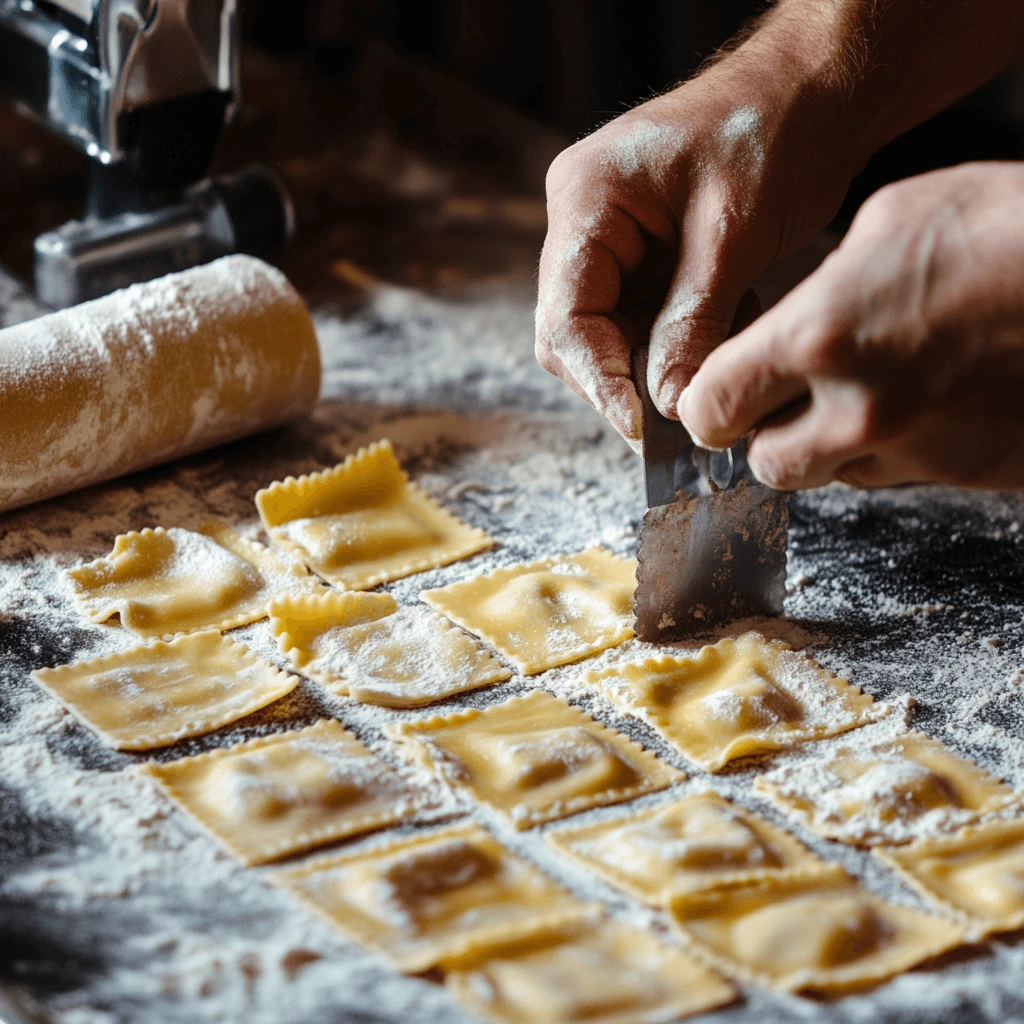There is something truly magical about sinking your fork into a plate of freshly made short rib ravioli. The soft pasta exterior gives way to a melt-in-your-mouth, savory filling that feels both comforting and gourmet all at once. In this post, we will explore why short rib ravioli is an irresistible choice for food enthusiasts, how it ties back to centuries of Italian culinary tradition, and precisely how to master every step from braising the meat to sealing the dough. Although this recipe involves multiple stages, do not worry. With clear instructions and a bit of patience, you can bring restaurant-quality flavors directly into your home kitchen.
Why Short Rib Ravioli Is the Ultimate Comfort Food
Many home cooks initially associate ravioli with cheese fillings or ground beef mixtures, yet short rib ravioli elevates this classic dish to a new level of richness and depth. Whether you serve it for a special occasion or a cozy family dinner, you will be amazed by just how satisfying a plate of these tender pillows can be. Moreover, short rib ravioli offers you the chance to explore braising techniques, homemade pasta dough, and flavorful ingredient pairings in a single recipe.
A Brief History of Ravioli and Its Italian Roots
To understand how short rib ravioli gained popularity, it helps to look at the broader history of ravioli itself. Originally believed to have been invented in Northern Italy—some say in the Emilia-Romagna region—ravioli were a festive food prepared for celebrations. Indeed, pasta with fillings of cheese, vegetables, and herbs was considered a labor of love. Over time, regional variations emerged, and families began experimenting with new fillings, such as delicate meats or seasonal produce.
Eventually, ravioli transcended simple peasant food to become a symbol of Italian culinary artistry. Prepared with care during holidays, it was served in hearty broth or with robust sauces. In fact, the practice of sealing flavorful stuffing in dough has been adopted across different regions, with local tweaks that reflect each area’s ingredients. Thus, the tradition of filled pasta remains a beloved hallmark of Italian cuisine. Today, short rib ravioli is one of the tastiest offshoots of this ancient tradition, bringing tender beef and savory aromatics together in a comforting package.
f you’re curious about more traditional Italian ravioli variations, check out this classic ricotta and spinach ravioli recipe from Academia Barilla.
Why Braised Short Ribs Make the Best Filling
Short ribs are prized for their flavor and succulent texture, especially after slow-cooking or braising. Consequently, when the meat is shredded and combined with complimentary ingredients, it becomes an unforgettable filling. Short ribs boast a marbling that transforms into deep, meaty richness as it braises, making them a perfect contrast to delicate pasta dough. Furthermore, because short ribs naturally pair well with aromatic herbs—like rosemary or thyme—the resulting filling is both complex and comforting.
Some might wonder why they should choose short ribs over ground beef. First, the slow-cooking technique that you apply to short ribs amplifies their flavor significantly. Second, short ribs release natural juices that merge with braising liquid to create a luscious sauce or reduction. Therefore, you get an enhanced meaty taste compared to a quick-cooked ground beef. Finally, the shredded texture makes your ravioli incredibly satisfying, ensuring every bite bursts with savory goodness.
A Dish That Feels Both Gourmet and Cozy
What truly distinguishes short rib ravioli is its unique ability to feel both refined and comforting. On the one hand, this dish looks and tastes upscale enough for special gatherings, date nights, or holiday feasts. On the other hand, its rustic roots and homestyle braising method offer a heartwarming sense of familiarity. Consequently, you can serve it at formal occasions or simply enjoy it on a quiet weeknight, knowing you are savoring a slice of Italian culinary tradition in every bite.
Additionally, short rib ravioli lets you experiment. You can pair it with a simple drizzle of olive oil, a classic tomato sauce, or a luxurious cream sauce. Each variation transforms the dish subtly, and you will soon find a favorite. Meanwhile, the gentle method of braising ensures the meat will remain moist and tender—a hallmark of truly satisfying comfort food.
Ingredients You’ll Need for Short Rib Ravioli

Before you begin, gather all necessary ingredients. Having everything prepped and ready—commonly known as mise en place—will streamline the process and help you produce consistently excellent results.
For the Braised Short Ribs
- Beef Short Ribs (bone-in or boneless): Aim for meaty pieces that will yield ample shredded meat.
- Herbs: Fresh rosemary and thyme, or any preferred Italian herb blend.
- Aromatics: Minced garlic, chopped onions, or shallots.
- Additional Flavors: Salt, black pepper, tomato paste, and beef broth.
- Optional Depth: If you want an even richer profile (without using alcohol), you can add a touch of balsamic vinegar or extra beef stock.
Short ribs benefit from a longer, slower cooking time, so plan ahead. Typically, you will braise them for two to three hours, or until they can be shredded with a fork.
For the Pasta Dough
- Flour: “00” flour is popular for its fine texture, yet all-purpose flour can work in a pinch.
- Eggs: Generally, around one large egg per 100 grams of flour, but you can adjust.
- Olive Oil: Just a drizzle for added elasticity.
- Salt: A pinch to enhance flavor.
Although making your own dough may seem intimidating, it is quite straightforward once you get the hang of kneading and resting. Moreover, homemade dough has a robust freshness that is difficult to match with store-bought ravioli.
For the Filling
- Shredded Short Rib Meat: From your braised short ribs.
- Cheese: A combination of ricotta and grated parmesan for both creaminess and salty tang.
- Seasonings: Additional salt, pepper, or dried herbs to taste.
- Egg Yolk: One or two yolks to bind everything together (optional, but often recommended for consistency).
Here, you are free to explore. Some cooks add finely chopped spinach or caramelized onions to the mix, although short ribs and cheese are usually enough to deliver that “wow” factor. Furthermore, you can season it boldly if you plan on pairing with a milder sauce, or keep it simple if your sauce will be more robust.
Optional Sauce Pairings
Choosing a sauce is a creative step that can drastically change the final flavor. Because short ribs are so savory, an equally rich sauce can be ideal. However, a lighter option can let the meat filling shine on its own.
- Brown Butter and Sage: Melt butter until it forms a nutty aroma, add sage leaves, and lightly dress your ravioli.
- Garlic Parmesan Cream: A velvety sauce made with cream, garlic, and parmesan that adds lusciousness.
- Mushroom Reduction: Sauté mushrooms with garlic and onion, then add broth, simmer, and reduce.
If you want to highlight the braised flavors, consider using some of the braising liquid as a base for your sauce. Strain it, reduce it until thick, and then drizzle it over the finished ravioli. As a result, you will have an extra layer of meaty complexity.
Step-by-Step: How to Make Short Rib Ravioli from Scratch
It may appear complex, but as you break each phase into steps, short rib ravioli becomes a fun culinary project. Ultimately, you will be rewarded with homemade pasta that bursts with flavor.
Braising the Short Ribs
- Sear the Meat: Heat a bit of olive oil in a heavy-bottomed pot. Season short ribs with salt and pepper, then brown them on all sides. This step adds depth, so be patient and let them develop a nice crust.
- Add Aromatics: Remove the short ribs momentarily. In the same pot, sauté chopped onions or shallots, minced garlic, and herbs until fragrant. Stir in tomato paste for extra richness.
- Pour in Liquid: Return the short ribs to the pot. Pour beef broth to almost cover the meat. If you like additional tang, add a small splash of balsamic vinegar.
- Simmer and Cover: Once the liquid reaches a gentle boil, reduce the heat to low. Cover the pot and let the short ribs braise for about 2–3 hours. Check occasionally, adding more broth if necessary, so they do not dry out.
- Shred and Reserve: When the meat is tender enough to fall apart, remove it and shred using forks. Strain the braising liquid and reserve it if you wish to incorporate it into a sauce or gravy.
Because you aim for a succulent filling, it is crucial to cook the short ribs until they are easily shreddable. Consequently, do not cut corners by rushing the braise; the time investment is key to getting that melt-in-your-mouth texture.
Preparing the Fresh Pasta Dough
- Measure and Combine Flour: For roughly four servings, use about 400 grams of flour. Form a well in the center on a clean work surface.
- Crack in Eggs: Typically, you will add around 4 eggs to 400 grams of flour. Sprinkle in a pinch of salt and a drizzle of olive oil.
- Mix and Knead: Use a fork to gradually pull flour into the eggs, forming a cohesive dough. Afterward, knead by hand for 8–10 minutes or until the dough is smooth and slightly elastic.
- Rest the Dough: Wrap the dough in plastic wrap, or place it under an upside-down bowl for at least 30 minutes. Resting allows the gluten to relax, making the dough easier to roll.
If the dough feels too dry, lightly wet your hands rather than adding too much water at once. Conversely, if it is sticky, dust your work surface with flour. Meanwhile, kneading builds structure, so ensure you do not skip it.
Assembling the Ravioli
- Roll Out the Dough: Divide your dough into smaller sections. Using a rolling pin or a pasta machine, flatten each piece into a thin sheet (level 5 or 6 thickness on most pasta rollers works well).
- Prepare the Filling: Combine shredded short rib meat with ricotta, grated parmesan, and seasonings in a bowl. If needed, add one egg yolk to help bind.
- Portion the Filling: Lay out one sheet of dough and place spoonfuls of the filling about 1–2 inches apart, depending on your ravioli size preference.
- Seal the Ravioli: Brush a light egg wash or water around each scoop of filling. Carefully place a second sheet of dough on top, gently pressing the spaces around the filling to remove air pockets. Then, use a ravioli stamp or a knife to cut into individual ravioli shapes.
- Rest or Refrigerate: Place the ravioli on a tray dusted with semolina or flour so they do not stick. At this point, you can cook them right away, refrigerate for a day, or freeze them.
Remember to handle the dough gently, especially when sealing. Moreover, removing as much air as possible is crucial to prevent the ravioli from bursting once in boiling water.
Cooking and Serving Short Rib Ravioli
- Boil Water: Bring a large pot of salted water to a rolling boil.
- Cook the Ravioli: Gently drop the ravioli into the water. Fresh pasta cooks quickly—often within 3–5 minutes. Wait until they float to the surface and remain there for about 30 seconds.
- Drain Carefully: Using a slotted spoon, transfer the cooked ravioli to a plate or directly to a pan with your chosen sauce.
- Add the Sauce: If you are using a warm sauce, keep it gently simmering in a separate pan. Then, carefully toss the ravioli to coat each one.
- Garnish: Top with additional parmesan, chopped herbs, or a drizzle of high-quality olive oil.
Throughout this step, monitor your ravioli closely. Overcooked ravioli might split, while undercooked ravioli can feel doughy.
Expert Tips for Perfect Homemade Ravioli Every Time

Although short rib ravioli may appear advanced, there are plenty of tips and tricks to ensure your home-cooked version turns out successfully. Because there are multiple points where small mistakes can happen, it helps to know how to sidestep them.
How to Avoid Common Pasta Dough Mistakes
- Balancing Moisture: If your dough is too dry, it will crack; if it is too wet, it will stick. Consequently, make small adjustments as you knead.
- Proper Kneading: Under-kneaded dough can tear during rolling, while over-kneaded dough becomes tough. Aim for a smooth texture that slightly bounces back when poked.
- Rest Time: Always let the dough rest for at least 30 minutes. In fact, this rest period allows the gluten strands to relax, making rolling far simpler.
Sealing and Shaping Tips
- Use Light Pressure: Overly vigorous pressing can stretch and tear your dough.
- Eliminate Air Bubbles: Gently press around the filling before fully sealing. Trapped air expands during cooking and can cause bursts.
- Egg Wash vs. Water: An egg wash can be more reliable in sealing the edges firmly, particularly if you plan to store the ravioli overnight.
Storage and Freezing Instructions
- Refrigeration: If you plan to cook within 24 hours, arrange ravioli in a single layer on a floured tray, cover them loosely with plastic wrap, and refrigerate.
- Freezing: If you want to keep them longer, place the tray in the freezer until the ravioli are firm, then store them in freezer-safe bags. This method prevents them from sticking to each other.
- Cooking from Frozen: Drop the frozen ravioli directly into boiling water. Consequently, they will require about a minute or two more than fresh ones.
Sauce Pairing and Plating Ideas
- Light Drizzle: Sometimes a simple drizzle of herbed olive oil or a spoonful of the braising reduction is enough to let the filling shine.
- Creamy Sauces: If you crave indulgence, a garlic parmesan sauce or mushroom cream sauce beautifully complements the hearty meat.
- Presentation Tips: Plate your ravioli on a warm dish, garnish with fresh thyme or basil, and finish with a sprinkle of grated parmesan cheese. Although it seems optional, these small details often bring everything together visually and add extra flavor.
For more pasta-making inspiration, check out our tips for creating delicious lumache pasta dishes.
If you love hearty beef-based recipes, don’t miss our guide on how to make the perfect beef pepperoni at home.
FAQs About Short Rib Ravioli
Curious cooks often wonder how to store, cook, and customize short rib ravioli. Below are some common questions that arise when tackling this pasta project at home.
Can I Make Short Rib Ravioli in Advance?
Yes, you can certainly prepare short rib ravioli ahead of time. Many people braise the short ribs a day in advance, shred the meat, and store it in an airtight container. Then, you can form the ravioli whenever you have time. If you are not cooking them the same day, be sure to follow proper refrigeration or freezing methods. This strategy will help you serve short rib ravioli at peak freshness on the day you need it.
What’s the Best Sauce for Short Rib Ravioli?
The “best” sauce ultimately comes down to personal taste. If you enjoy creaminess, a garlic parmesan sauce might be your top choice. If you prefer to taste the savory filling more directly, a simple drizzle of reduced beef broth or olive oil and fresh herbs will do. Meanwhile, those looking for an earthy, rustic flavor may try pairing their ravioli with a mushroom sauce. Therefore, test different approaches until you discover your favorite flavor balance.
Can I Use a Pasta Machine for the Dough?
Absolutely! Using a pasta machine—especially if you are new to homemade pasta—can make rolling out the dough much easier. In fact, a machine ensures consistent thickness, reducing the chance of tearing or uneven cooking. Start on the widest setting and gradually move to thinner ones until you reach your preferred thickness. Many cooks find that a setting corresponding to about 1/16 inch thickness offers a good balance of sturdiness and delicacy for ravioli.
Can I Make It Without Alcohol?
Yes. In this recipe, there is no alcohol required. Instead of wine, you rely on rich beef broth, onions, and a small spoonful of tomato paste to develop flavor depth. If you like a subtle tang, you can use a dash of balsamic vinegar (completely optional). Hence, your final product remains free of alcohol while still delivering the savory essence associated with braised short ribs.
Final Thoughts on Short Rib Ravioli
Short rib ravioli might be one of the most comforting and gourmet dishes you can make in your own kitchen. Although it involves several stages—from braising to rolling and sealing—the final result is undoubtedly worth it. Each tender bite of short rib is encapsulated in homemade pasta dough, resulting in a luxurious meal that truly feels like “pure magic.”
Furthermore, by mastering this dish, you also gain valuable cooking skills such as braising, dough preparation, and sauce creation. These newfound abilities open the door to countless variations, allowing you to adjust herbs, filling ingredients, and sauce choices to your liking. Should you decide to whip up short rib ravioli for a dinner party, a family gathering, or just a personal treat, rest assured that everyone will savor this enchanting dish.
Finally, do not forget to let your own creativity shine. Feel free to garnish with fresh herbs, shave some extra cheese on top, or experiment with different sauce flavors. By adapting these steps and tips, you might even develop your own signature recipe. So gather your beef short ribs, flour, and aromatic herbs, and experience firsthand the magic that is homemade short rib ravioli.


1 thought on “How to Make Perfect Short Rib Ravioli at Home: A Pure Magic!”